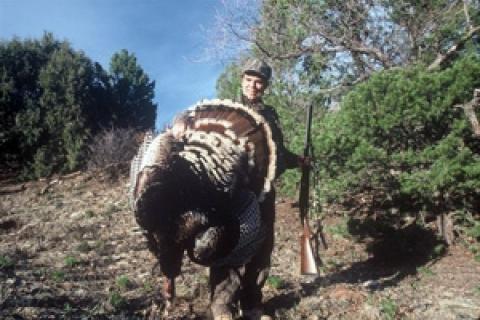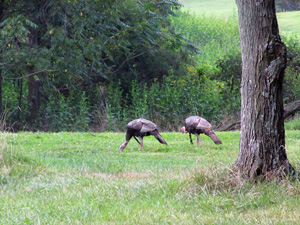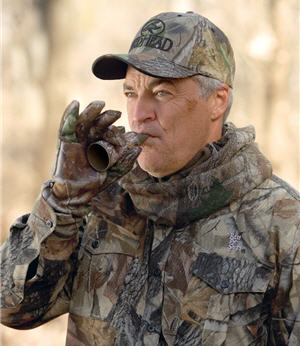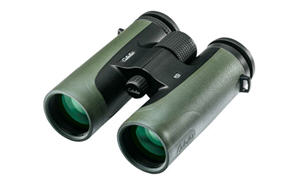
If you're just getting started in fall turkey hunting or have tried but aren't happy with your success rate, here's a rundown on some of the most common mistakes that can ruin an autumn outing and more importantly, how you can avoid them. Eliminate all of these potential flub-ups and you should up your odds considerably for taking home a tom or hen this fall as your reward for a hard day's hunting.
 1. Not scouting enough. You can walk until your legs collapse and not have any luck if you're in the wrong location. Check with game wardens, wildlife biologists, loggers, local sporting goods stores and national forest rangers to pin down where birds are being seen. Once you have a lead on a good area or two, or if you know from past experience birds use that location in the fall, the footwork begins. You can do this before or during the season. Walk out logging roads and along ridges. Also try glassing from high ridges or fire towers.
1. Not scouting enough. You can walk until your legs collapse and not have any luck if you're in the wrong location. Check with game wardens, wildlife biologists, loggers, local sporting goods stores and national forest rangers to pin down where birds are being seen. Once you have a lead on a good area or two, or if you know from past experience birds use that location in the fall, the footwork begins. You can do this before or during the season. Walk out logging roads and along ridges. Also try glassing from high ridges or fire towers.
2. Not hunting prime areas. Forget the marginal areas. Concentrate on the best locations to increase your odds of success. Good habitat for turkeys in fall includes woods with abundant mast, field edges, hollows, ridges, junctures of gullies, clear-cuts, and edges where hardwoods meet pines, young timber meets mature woods, etc.
![]() Tip: An ideal fall turkey hunting area has a good mix of open and wooded habitat with varying age classes of hardwood timber plus conifers for roosting.
Tip: An ideal fall turkey hunting area has a good mix of open and wooded habitat with varying age classes of hardwood timber plus conifers for roosting.
 |
| Don't ingore prime foods other than acorns, as when crops are poor, turkey feed on other items like wild grapes, wheat and oats. |
3. Failing to locate water holes. Turkeys need water every day. They get some of it from dew and puddles from rain, but often they'll go to a water hole, tank, stream or pond once a day. Find these areas and you can either hunt near them or use the sign to learn which ways they are coming from and heading towards after they drink.
4. Ignoring prime foods other than acorns. Sure, acorns are often the number one food for turkeys in the fall. But many years mast crops are poor and they must feed on other items. And a particular area may have lots of birds but not very many nut trees. In that case check out these prime turkey foods: wild grapes, chufa, wheat, oats, greenbrier, corn, persimmon, clover, hawthorn, mountain ash, berries and insects such as beetles, grasshoppers, crickets and grubs.
5. Not trying to discover patterns in an area's turkey flock movements. To some extent, turkeys move randomly in the fall. If they see a nut here or a berry patch there, they'll head that way. But usually there are general patterns to their travels. Determine where the birds roost, water and head out to feed in the morning. Find out where they loaf and dust their feathers during midday. With this knowledge, you can often pinpoint where you can intercept the birds.
6. Not paying enough attention to subtle sign. Turkey sign comes in many different forms. And fall flocks, which can range from 3 or 4 old gobblers to 20 or more young birds and hens, leave a lot of it. You have to pay attention, though, to find it and interpret its meaning. Search for sign such as droppings, loose feathers, dusting areas and scratchings in the leaves. You can tell which way the birds are going by the direction the leaves are piled up. A turkey rakes leaves towards itself as it searches for food. This means they will be piled up in the direction they are coming from. The opposite direction is where they'll be heading.
7. Focusing on old sign. Turkeys move so far in a typical day, generally several miles, that finding old sign doesn't mean much. Focus on areas where the scratchings look fresh with the ground moist where the birds have raked away the leaves. Look for droppings that are shiny or wet looking rather than dried out and faded.

8. Using the wrong firearm and ammunition. Some hunters go out in the fall on multi-species hunts, hoping they might encounter a squirrel, rabbit, grouse, or if they're lucky, maybe a turkey. That's not the way to score on autumn birds. The gun choke and ammo for small game is not suitable for a turkey that could weigh 10 or 12 pounds. Use a 12 gauge 3-inch shotgun or 20 gauge 3-inch shotgun with a full choke. Specially designed turkey shotguns are the best  bet. The gun should be either camouflaged or have a dull matte finish to avoid spooking birds.
bet. The gun should be either camouflaged or have a dull matte finish to avoid spooking birds.
The majority of your shots will be taken at birds you are calling in from a sitting position, just like in spring. Use heavy loads of size 4, 5 or 6 shot, depending on what patterns best in your gun out to about 40 yards.
 |
| RedHead Blaze Cap |
9. Not wearing full camouflage. Some hunters think because lots of fall turkeys taken are young-of-the-year they don't have to be as cautious or meticulous about their camouflage hunting clothing. Nothing could be further from the truth. For one thing, you may be trying to fool a wary old hen. Or you may get lucky and bust up a small flock of mature gobblers. In both cases you will need every speck of your human form camouflaged, including a mask or face paints and gloves for the hands.
Keep a blaze orange hat handy in heavily-hunted areas and wear it while walking through the woods. But put it in your turkey hunting vest when trying to call in birds. Also wrap any turkey you bag in blaze orange before walking out after the hunt.
 |
| RedHead Bucklick Creek Turkey Lounger Vest for Men |
10. Not stocking the right extra gear. Two things are vital for a successful hunt. One is a sling. You'll do lots of walking and unless you are in a prime turkey area, it's often less tiring to wear the gun over your shoulder with a comfortable sling. Also bring a special turkey vest to carry extra shells, lunch, turkey calls, hunting knife, camera, water and other miscellaneous gear. And if you can own a turkey vest that has a fold-down padded hunting chair built in like the RedHead Bucklick Creek Turkey Lounger Vest. Remember, you may have to call for quite a while to lure in a busted up flock of birds.
11. Not blind calling. The ultimate goal of turkey hunting in fall is to find a flock, break it apart and then call birds back in. Most hunters just think walking is the best way to get the job done. But it pays to stop occasionally, especially if you've seen fresh sign and call blindly.
There may be a flock just over a rise or down he hollow that you would walk past if you didn't know they were there. Birds won't always answer, but at times they will and it's worth the effort occasionally as you work through the woods. Try yelping, simple clucks or kee-kee runs. Also experiment with different designs of calls. Some days a diaphragm might work best, the next day a box, push-pin, slate or wing-bone might produce a response. Once you hear a bird, you can decide whether to try to call it in from where you are, move a bit closer and call, or move in and try to bust up the flock and then call them back.
![]() Tip Watch Video: Can you Turkey Call Like a Pro?
Tip Watch Video: Can you Turkey Call Like a Pro?
![]() Tip: Shop turkey calls at Bass Pro Shops
Tip: Shop turkey calls at Bass Pro Shops
 12. Not listening. When you pause to call a gobbler, first simply remain silent and listen. Turkey flocks feeding through the woods make a lot of noise. You might hear leaves scuffling or quiet purring and clucking between birds or wings whooshing as one bird tells another: "back off-you're getting too close." If your ears are bad, use one of the special hearing amplifiers sold for hunters.
12. Not listening. When you pause to call a gobbler, first simply remain silent and listen. Turkey flocks feeding through the woods make a lot of noise. You might hear leaves scuffling or quiet purring and clucking between birds or wings whooshing as one bird tells another: "back off-you're getting too close." If your ears are bad, use one of the special hearing amplifiers sold for hunters.
13. Not using optics. Fall turkey hunting is mostly a walking and listening game. But if you are in semi-open areas, using binoculars like the Cabela's Intensity HD Binoculars to scan ridges and valleys ahead can be a help. You might locate a flock and be able to see which way it's feeding. Then you can head straight for a good ambush spot ahead of that direction and be waiting for them.
 |
| Cabela's Intensity HD Binoculars |
14. Not trying to roost birds. If you can get out late in the day, just before sunset the day before your hunt, you might be able to put a flock to bed. About 30 minutes before sunset listen for the whoosing wings and snapping branches or soft calls turkeys make as they fly up to roost. Pinpoint this spot and be positioned close by the next morning right at daylight. You might call one in straight off the roost. And if that fails, the flock will be right in front of you and fairly easy to rush into and scatter.
15. Not getting an early enough start. Even if you haven't roosted a flock, try to be out at first light. Birds make a lot of noise as they fly down out of trees, and they often call more at daybreak than any other time of day during fall. The early riser will be the one able to take advantage of this.
16. Not scattering a flock well enough. Certainly sometimes other tactics will work besides scattering and calling the birds back. You may get ahead of a flock and ambush it. You might find a lost bird that comes in to your calls alone. Usually, though, breaking up a group and then calling them back in is best bet-and the most fun!
But to succeed you need a good break. Either place the gun on the ground or make sure the safety is on and rush towards the birds, but don't do this so violently that you might trip or injure yourself. No turkey is worth that. Be as forceful as you can while being careful. Yell, wave your arms, or when stopped, even shoot a shell into the ground. The aim is to get the birds to fly off in as many directions as possible. That way they'll be anxious and lonely and want to regroup by calling to each other.
 17. Calling too quickly. Once a flock scatters, don't start calling immediately. The best approach is to wait 30-60 minutes unless they start calling on their own. Once they do, or after 30 minutes elapse, call back with the same calls they are using kee-kees, yelps or clucks. If you call immediately after scattering the flock, older hens will be suspicious and may lead the younger birds away.
17. Calling too quickly. Once a flock scatters, don't start calling immediately. The best approach is to wait 30-60 minutes unless they start calling on their own. Once they do, or after 30 minutes elapse, call back with the same calls they are using kee-kees, yelps or clucks. If you call immediately after scattering the flock, older hens will be suspicious and may lead the younger birds away.
18. Not taking the proper position. When calling, make sure you keep the proper form so you'll have the stamina to wait out birds. Sit with your back against a wide tree, knees up, with the gun propped over the opposite knee from your shooting eye. That way you can be most comfortable and hold out the longest if the birds are wary and slow to come in.
19. Not aiming properly. Don't aim at the turkey's big body. Always aim at the head and neck. Keep your cheek down tight on the stock. Make sure the bird is within clear range with no brush in the way before pulling the trigger.
20. Getting discouraged. Sometimes fall turkey hunting is easy. But usually it's tough, with lots of hard, tiring walking required and many hours of effort expended to even see a flock. Don't give up. The more time you put in, the more ground you cover, the better the odds are that you're about to stumble upon a big flock of birds.
![]() Tip: No Membership Required: At-Home Hunter Specific Workouts
Tip: No Membership Required: At-Home Hunter Specific Workouts
![]() Tip: 4 Exercises Hunters Can Do Without a Pricey Gym Membership
Tip: 4 Exercises Hunters Can Do Without a Pricey Gym Membership
When you do, and they fly in every direction and you hear calling all around you from the scattered birds, all the effort will seem worthwhile. And when you bag one of those toms or hens with a clean shot on a crisp autumn afternoon with the smell of fresh fallen leaves in the air, you'll have experienced one of hunting's sweetest moments.
- 10076 views

